By Alena Sokhan // Sept. 15, 2015
French sculptor and artist Caroline Mesquita is using the large space in the basement of the carlier | gebauer as a studio for the last few months, creating large humanoid figures out of metal, scattered throughout the basement rooms. She seems very comfortable in this space, easily maneuvering the different rooms and stacks of old works, though she told me she was having a bit of trouble as she had injured one eye recently and that affected her ability to perceive depth.
I had already noticed that Mesquita had a white medical eye-patch over her eye: later she lamented she did not have a more authentic and fashionable fabric one. “One of my characters hit me in the eye” she told me suddenly, in the middle of the interview, “I was working and something fell and hit me right in the eye”. She assured me the injury was healing quickly, then laughed and said that there is something oddly terrifying that her own fictional character attacked her eye. She has a deeply affective relationship to her sculptures, and is highly intuitive to how her installations interact with visitors and the space. She shows me what she is working on and answers some of my questions about how to relate to her works and what kind of a space these human-like metal bodies create.
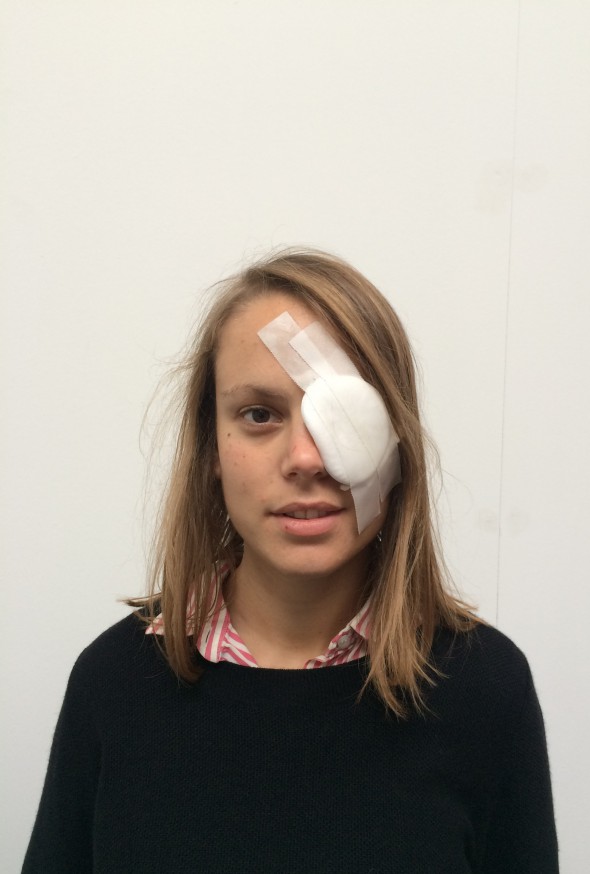
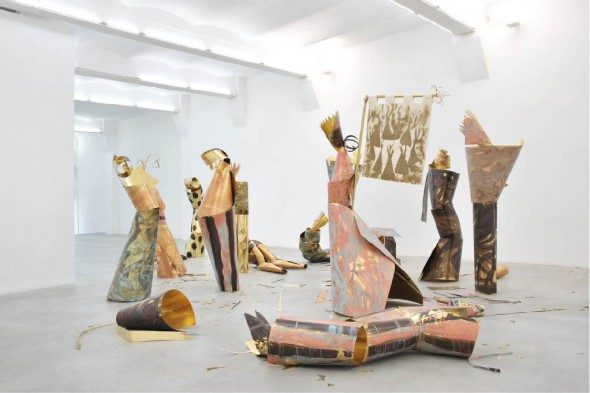
Caroline Mesquita: Bal, 2015, installation from oxidized brass, spotlights, sound // photo by Rebecca Fanuele, courtesy of the artist
Alena Sokhan: Without giving too much away, what are you working on for Berlin Art Week?
Caroline Mesquita: Right now I am working on an installation for abc – art berlin contemporary, and also on a show I will have at carlier | gebauer in November. For the art fair I am working on an installation that will have four walls made of steel in a sort of line with a group of eight human-sized characters made in brass. The main figures will be these two women who are standing on the walls, dancing almost, or in a very expressive, upward position. And the others will be male, standing around also looking up at the women.
I have recently been learning more about marginaux life and culture. So the scene is very eccentric, just people hanging around outside, the kind of people you see just talking and doing nothing in public spaces, like parks or street corners. I like this sort of life because it is marginal to society, people who lead a more artistic or creative life. To me the unconventional lifestyles of outsider types open new possibilities to how we can live our lives and what we value.
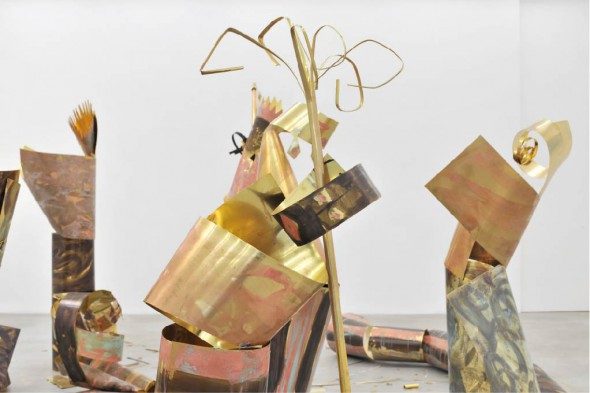
Caroline Mesquita: Bal, 2015, installation from oxidized brass, spotlights, sound // photo by Rebecca Fanuele, courtesy of the artist
AS: Any mention of people dancing on a wall in Berlin makes me think of the fall of the Berlin Wall, is that something you are referring to as well?
CM: No, I don’t think so. It is a very different type of wall that I am making – more like a step that people can sit on, rather than a higher wall that blocks in a space or creates a limit.
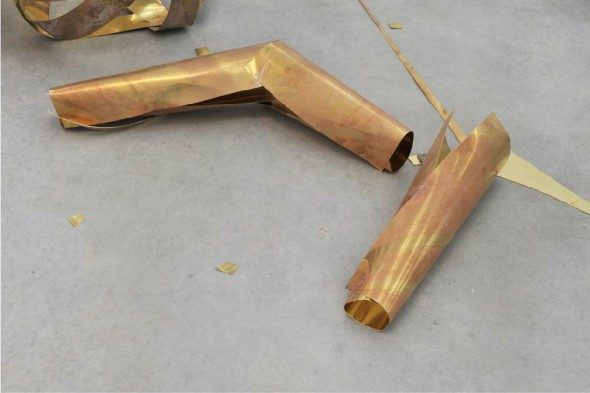
Caroline Mesquita: Bal, 2015, installation from oxidized brass, spotlights, sound // photo by Rebecca Fanuele, courtesy of the artist
AS: What about the role of gender in this scene?
CM: That’s very important for me. I am really exploring gender, physical and social relations in my works, especially in the recent ones. I started using human-sized bodies in my earlier works in order to introduce a body or visitor into the installation who is there before the viewer, but now I begin to be more interested in exploring community dynamics.
So for this installation for abc I thought of having only one woman at the start but I found that a bit too rigid or generic somehow, so I made two. The composition will be very triangular and upward, like you see in classical Western paintings. I was inspired by these strong, feminist figures like ‘Victory of Samothrace’ or Delacroix‘s ‘Liberty Leading the People’. I like how in these works there are all these men who are drawn to the women and inspired or impelled into action by the women.
AS: Why is it necessary that these works are sculptural and three dimensional?
CM: I started my practice with an interest in space, really trying to understand how I could produce a work for a particular space and time. I used human-sized, human-like sculptures in order to create a relation to the artwork that’s more intimate and physical and affective, since it feels a little ambiguous: are you looking at an object or a subject? So I chose positions for the characters that are particularly dynamic, full of energy and tension. I often think of them as petrified.
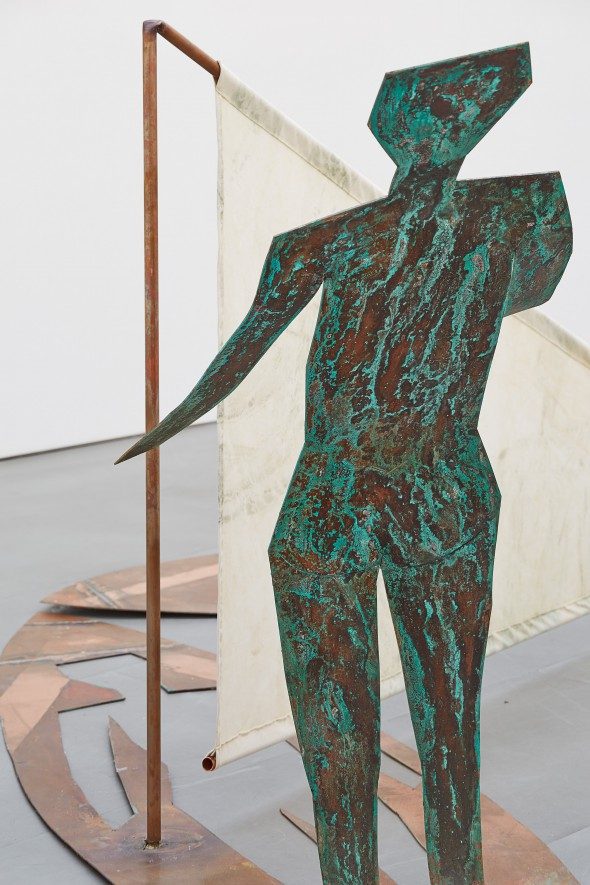
Caroline Mesquita: Windsurfers, 2015, installation from brass, chemically treated brass, chemical prints on fabric from brass, sound // photo by Nick Ash, courtesy of the artist and Carlier|Gebauer Gallery
I like to imagine that objects have a life of their own when we are not looking at them. I spend so much time alone here with these characters, sometimes I talk to myself too, and I start to feel like they are good friends of mine. I really like the autonomy that these sculptures have from me, they have their own personalities.
In the scenes and installations I do now I use space to explore relations between figures, which is a space of ambiguity, of not quite concrete attractions and enunciations. The hands of the figures are in a position of protestation, or proclamation, as if they wanted to say something. But it also looks like women surrounded by their admirers or lovers. Or people dancing. Their positions are very expressive in this way.
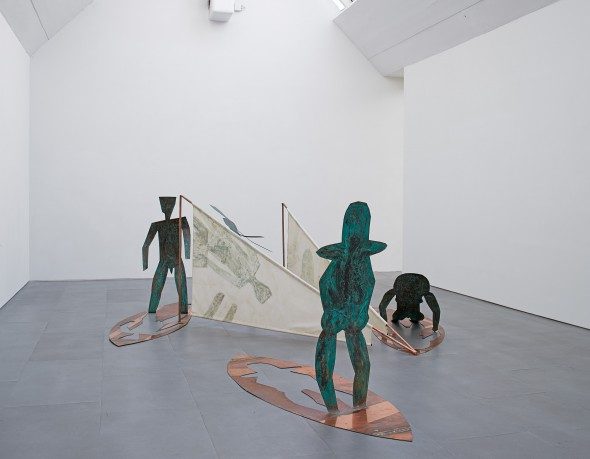
Caroline Mesquita: Windsurfers, 2015, installation from brass, chemically treated brass, chemical prints on fabric from brass, sound // photo by Nick Ash, courtesy of the artist and Carlier|Gebauer Gallery
AS: Why are you so attracted to using metal for your sculptures?
CM: I work with metal because it also has character and it responds to me immediately when I am working with it. I can work alone and be involved in the whole process of making these sculptures. Metal has a lot of its own properties and qualities, and oxidizes very differently depending on what sort of chemicals you are using and where the metal and chemicals come from. So while I have an idea and an image I want to realize, I have allow the characters to take their own forms. It’s like raising a child: you can educate and guide but you don’t have control over how they grow up.
AS: Some of your works are quite sexually charged. Can you tell us about the sexuality of these inanimate, human-like sculptures?
CM: The works that dealt more overtly with sexuality and basic drives were earlier works of mine. I was interested in sexuality as a basic, physical form of attraction. But I think I have developed to be curious about more complex relations. I think appearances are very complicated, and I am trying to explore how physical and social relations are built from appearances, fashion, behaviors, energies. I am fascinated in the ambiguity of appearances, in transvestites, in performing gender and social roles and the sort of chaos and madness that underlies the social and political positions we adopt.
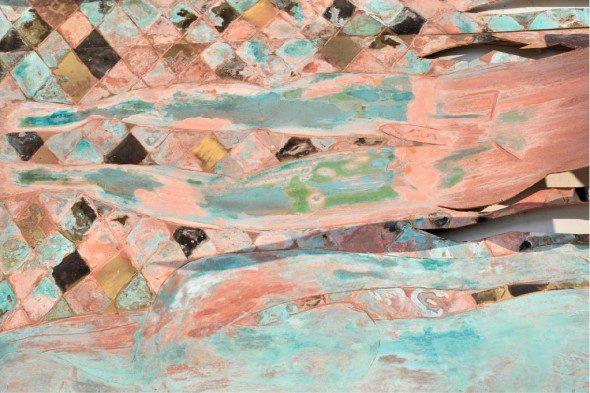
Caroline Mesquita: Us, 2014, installation from oxidized brass, spotlights, sound // photo by Rebecca Fanuele, courtesy of the artist
AS: So how do you find Berlin? It’s quite a bohemian and sexually open city that really seems to welcome an alternative lifestyle?
CM: Well, I have been here for 3 months now and I really like it. It’s very different from what I am used to in Paris. In cities like London and Paris, and New York, there is this manic speed, and you don’t feel comfortable if you don’t go to work every day. So even as an artist you end up in this very conventional work schedule, which is very strange, to be creative every day from morning to evening. But in Berlin I don’t find that at all. I feel more comfortable experimenting with different types of schedules and working in my own rhythm. Life is more affordable here and that takes away a lot of pressure. I still like the madness and energy of Paris, I feel like I need it a little. But I really have had a great time in Berlin.
Additional Information
ABC – ART BERLIN CONTEMPORARY
Exhibition: Sept. 17–20, 2015
Opening: Thursday, Sept. 17; 4–9pm
Luckenwalder Straße 4–6, Berlin, click here for map


























